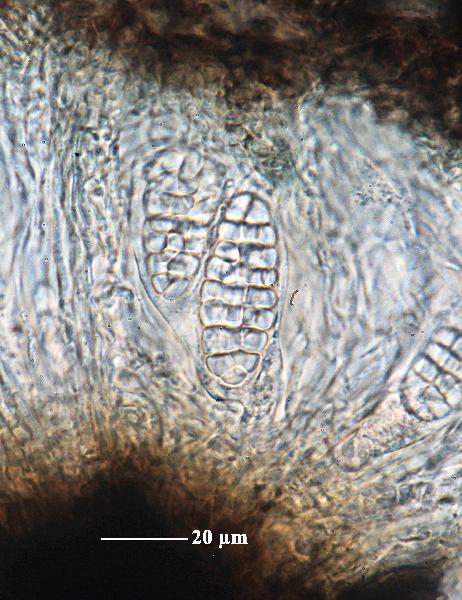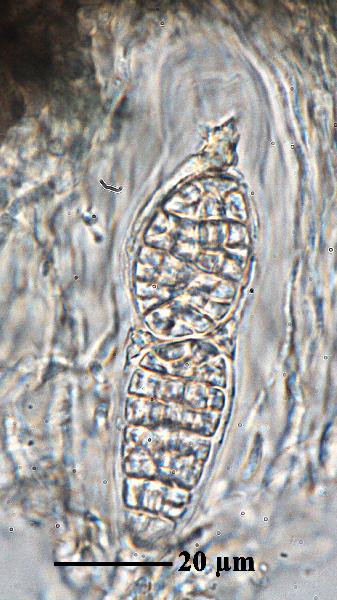Rhizocarpon subgeminatum Eitner
Jahresber. schles. Ges. vaterl. Kultur, 88, 2: 42, 1911 (1910).
Synonyms: Rhizocarpon phaeolepis Vain.
Distribution:
Description: Thallus crustose, episubstratic, brown to grey-brown, areolate, forming up to 10 cm wide patches delimited by a black prothallus, the areoles contiguous to dispersed on a black hypothallus, 0.3-0.6(-1) mm wide, flat to slightly convex, polygonal to rounded, epruinose. Medulla white, I-. Apothecia lecideine, black, rounded, irregularly arranged, (0.2-)0.3-0.5(-0.7) mm across, with a flat to slightly convex disc and a (0.04-)0.05-0.11 mm thick, distinct and persistent proper margin. Proper exciple brown in outer and lower part, reddish in upper part, the reddish parts reacting K+ purple-red; epithecium brownish green to blue-green, K- or K+ intensifying green, N+ red; hymenium colourless, rarely brownish or greenish in upper part, (100-)139-220(-250) µm high; paraphysoids branched and anastomosing; hypothecium dark. Asci 2-spored, clavate, fissitunicate, with a well-developed tholus that is K/I- in lower part and K/I+ blue near the apex, lacking an ocular chamber, Rhizocarpon-type. Ascospores muriform, with (12-)16-25(-30) cells in optical view, long remaining hyaline, but turning light green when old, ellipsoid, (25-)30-50(-63) x (12-)20-28(-33) µm, halonate at least when young. Photobiont chlorococcoid. Spot tests: cortex and medulla K-, C-, KC-, P-, UV-. Chemistry: thallus without lichen substances. Note: on siliceous rocks, often near brooks and lakes; for the Alps most records are from the Eastern Alps, all of them outside Italy; to be looked for in the Italian Alps.
Growth form: Crustose
Substrata: rocks
Photobiont: green algae other than Trentepohlia
Reproductive strategy: mainly sexual
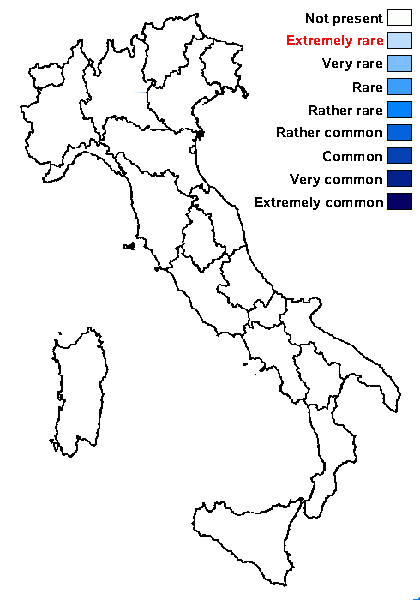
Predictive model
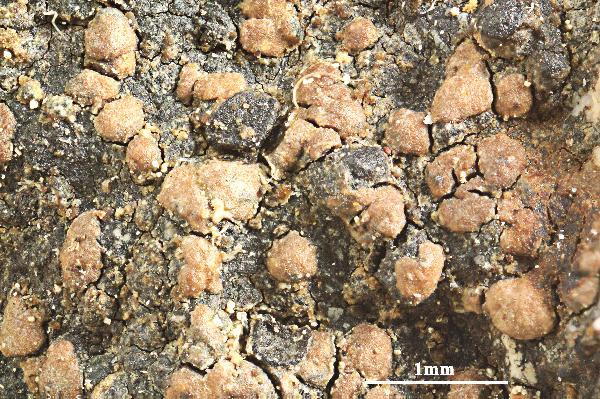

Felix Schumm - CC BY-SA 4.0
[8769], USA, Maine, Washington Co.: Steuben, Eagle Hill, Humboldt
Research Institut, Conifer-Maple-Forest, 44°27.588 N, 67°56.004 W,
87 m. Leg. F. Schumm, 20.08.2001, det. F. Schumm, 08.2001. - Sporen
muriform, zu 2, hyaline, 44,3 x 17,5 μm; Thallus K-.
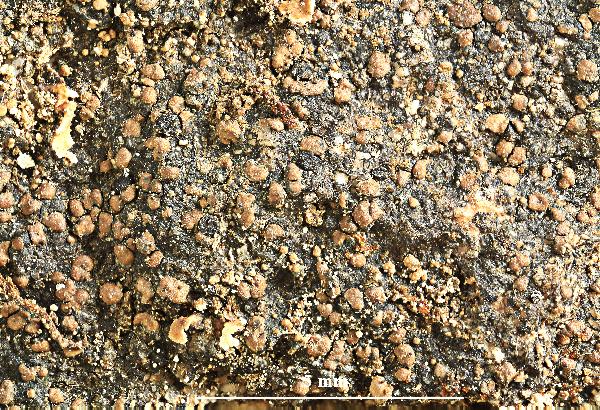

Felix Schumm - CC BY-SA 4.0
[8769], USA, Maine, Washington Co.: Steuben, Eagle Hill, Humboldt
Research Institut, Conifer-Maple-Forest, 44°27.588 N, 67°56.004 W,
87 m. Leg. F. Schumm, 20.08.2001, det. F. Schumm, 08.2001. - Sporen
muriform, zu 2, hyaline, 44,3 x 17,5 μm; Thallus K-.
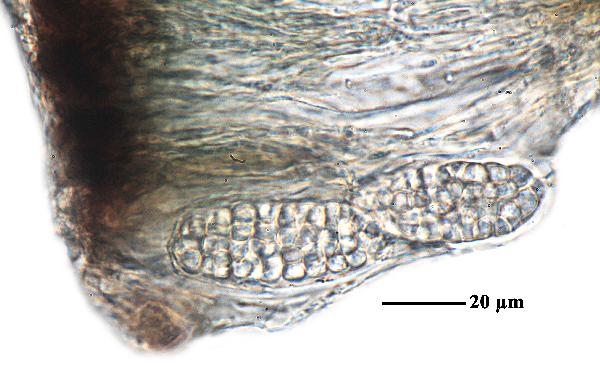

Felix Schumm - CC BY-SA 4.0
[8769], USA, Maine, Washington Co.: Steuben, Eagle Hill, Humboldt
Research Institut, Conifer-Maple-Forest, 44°27.588 N, 67°56.004 W,
87 m. Leg. F. Schumm, 20.08.2001, det. F. Schumm, 08.2001. - Sporen
muriform, zu 2, hyaline, 44,3 x 17,5 μm; Thallus K-.
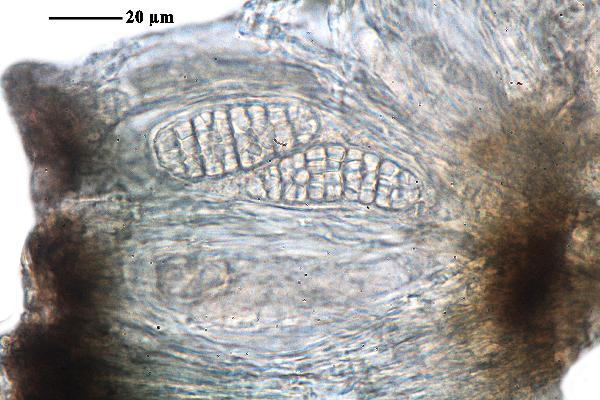

Felix Schumm - CC BY-SA 4.0
[8769], USA, Maine, Washington Co.: Steuben, Eagle Hill, Humboldt
Research Institut, Conifer-Maple-Forest, 44°27.588 N, 67°56.004 W,
87 m. Leg. F. Schumm, 20.08.2001, det. F. Schumm, 08.2001. - Sporen
muriform, zu 2, hyaline, 44,3 x 17,5 μm; Thallus K-.
Growth form: Crustose
Substrata: rocks
Photobiont: green algae other than Trentepohlia
Reproductive strategy: mainly sexual

Predictive model


Felix Schumm - CC BY-SA 4.0
[8769], USA, Maine, Washington Co.: Steuben, Eagle Hill, Humboldt Research Institut, Conifer-Maple-Forest, 44°27.588 N, 67°56.004 W, 87 m. Leg. F. Schumm, 20.08.2001, det. F. Schumm, 08.2001. - Sporen muriform, zu 2, hyaline, 44,3 x 17,5 μm; Thallus K-.


Felix Schumm - CC BY-SA 4.0
[8769], USA, Maine, Washington Co.: Steuben, Eagle Hill, Humboldt Research Institut, Conifer-Maple-Forest, 44°27.588 N, 67°56.004 W, 87 m. Leg. F. Schumm, 20.08.2001, det. F. Schumm, 08.2001. - Sporen muriform, zu 2, hyaline, 44,3 x 17,5 μm; Thallus K-.


Felix Schumm - CC BY-SA 4.0
[8769], USA, Maine, Washington Co.: Steuben, Eagle Hill, Humboldt Research Institut, Conifer-Maple-Forest, 44°27.588 N, 67°56.004 W, 87 m. Leg. F. Schumm, 20.08.2001, det. F. Schumm, 08.2001. - Sporen muriform, zu 2, hyaline, 44,3 x 17,5 μm; Thallus K-.


 INDEX FUNGORUM
INDEX FUNGORUM
 GBIF
GBIF
